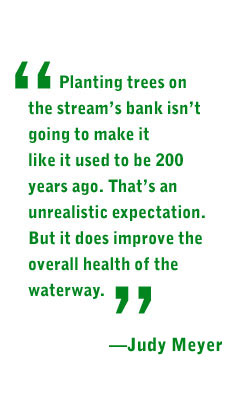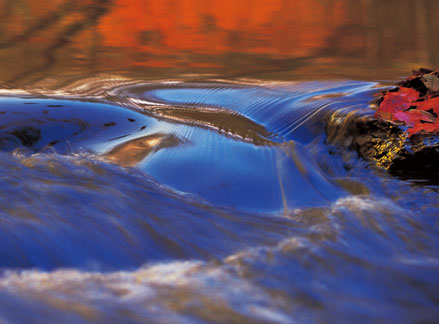


The River Doctor Is In
by Kathleen Cason
Intro
| The Urbanization of Judy
| Elements of Restoration
| Guiding Policymakers


The Urbanization of Judy
Throughout her career, Meyer has been interested in the food web of streams. As leaves fall into streams and decay, organic material leaches out and that becomes the primary food source for microbes. Aquatic insects eat the microbes and then in turn become food for fish.
“If I have made a contribution to science, it has been emphasizing the important contribution of microbes to the food web in streams,” she said. “The microbes are crucial for supporting the web of life in the river as a whole. They feed the food web.”
Her early studies involved headwater streams — the network of small upstream creeks that flow into larger streams — at the Coweeta Hydrological Lab in the Southern Appalachians. Meyer and colleagues have monitored the effect of clear cutting on a stream in the Coweeta watershed and found that some aspects of stream health recover within a decade but ecosystem function has not been fully restored even after 25 years. She also pursued her interest in the food web, examining the role of dissolved organic carbon. By the mid-1980s, she continued studying the role of organic carbon in the Ogeechee River, a blackwater river that flows through swamps and wetlands in Georgia’s coastal plain.

After the Clean Water Act passed more than three decades ago, billions were spent on sewage treatment plants, loss of wetlands slowed, and the most severely polluted waterways began to recover. Even so, more than 40 percent of the nation's freshwater rivers and lakes are unsafe for fishing or swimming today.
“I started out my career working in the mountains and working on blackwater rivers,” Meyer said. “Then I had a midlife crisis. I remember waking up one morning and realizing that the streams around here [in the city of Athens] aren’t like the streams I’d been studying. They’re filled with sediments, they’re channelized, they’re running through culverts.
“A number of my colleagues said, ‘Oh Judy, urban streams are so trashed. Just write them off,” Meyer said.
Instead, she began to look at urban streams.
In the Atlanta-area, she examined the ability of urban streams to remove excess nutrients from the water. She and her colleagues and students compared streams in forested, agricultural, suburban and urban watersheds. They found that the more urban the watershed, the less able streams are to remove nutrients.
“It’s more than overloading stream systems with nutrients,” Meyer said. “When it rains, urban streams flood more quickly because the vegetation may have been removed along the banks or the channel has been straightened or the stream runs through a pipe. Even if you have a healthy riparian zone, once the leaves fall in they aren’t held in place because you have frequent floods coming through.”
Leaves in urban streams are swept downstream in the frequent floods or are physically battered to bits, not allowing microbial processes to release the organic carbon that fuels the bottom of the food web.
Elizabeth Sudduth, a recent UGA master’s student with Meyer, examined the effect of stream restoration on urban stream health. Sudduth, now at Duke University, compared the health of unrestored streams in Atlanta to restored streams where local government or AmeriCorps groups had stabilized eroded stream banks with coconut fiber, willow cuttings and plantings. She found that bank stabilization with vegetation improved shelter and food supply for keystone aquatic insects, the “canaries in the mine” of stream health. Sensitive aquatic insects are absent from streams with excess nutrients or too much sediment. So like the sensitive canary in the mine, the presence of aquatic insects is an indicator of stream health.
In Sudduth’s study, the stabilized banks supported a healthy circle of life. Plants supply the leaves and organic materials that feed the microbes that feed the insects that feed the fish. Plants along the stream can absorb water, reduce flooding, and improve the stream’s ability to remove excess nutrients introduced by human activity.
“I went into this project with the idea that this bank stabilization was just a Band-Aid on a huge problem,” Sudduth said. “I didn’t know if it would actually make a difference. But it does. That was a good surprise.”
“Planting trees on the stream’s bank isn’t going to make it like it used to be 200 years ago,” Meyer said. “That’s an unrealistic expectation. But it does improve the overall health of the waterway.”
Intro
| The Urbanization of Judy
| Elements of Restoration
| Guiding Policymakers
For comments or for information please e-mail: rcomm@uga.edu
To contact the webmaster please email: ovprweb@uga.edu
![]()